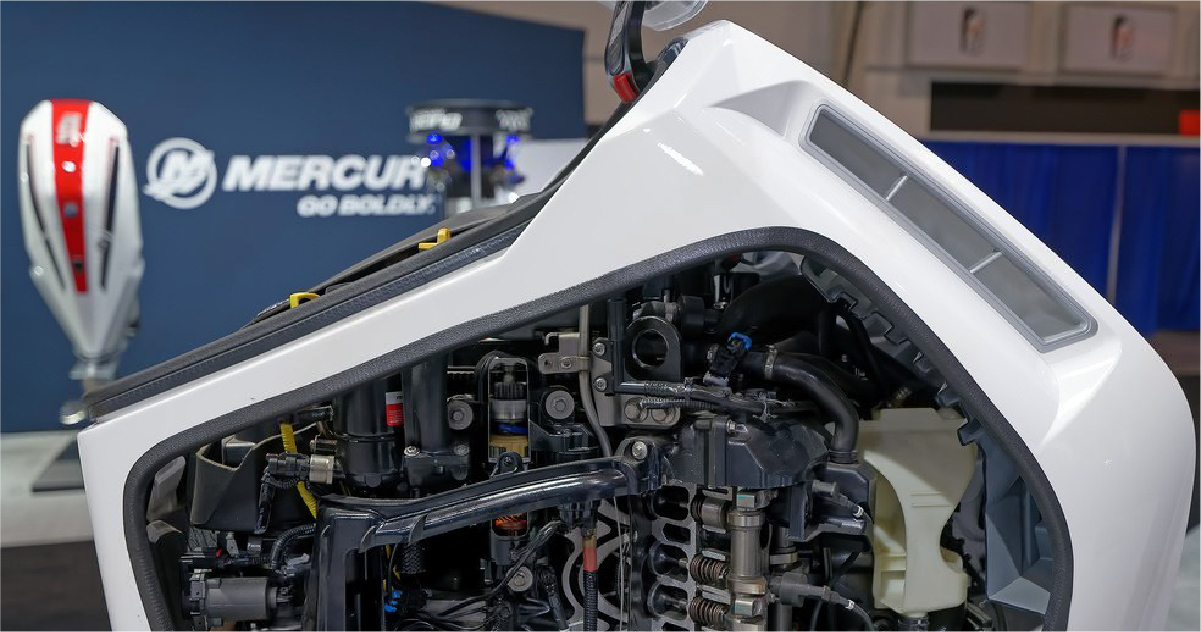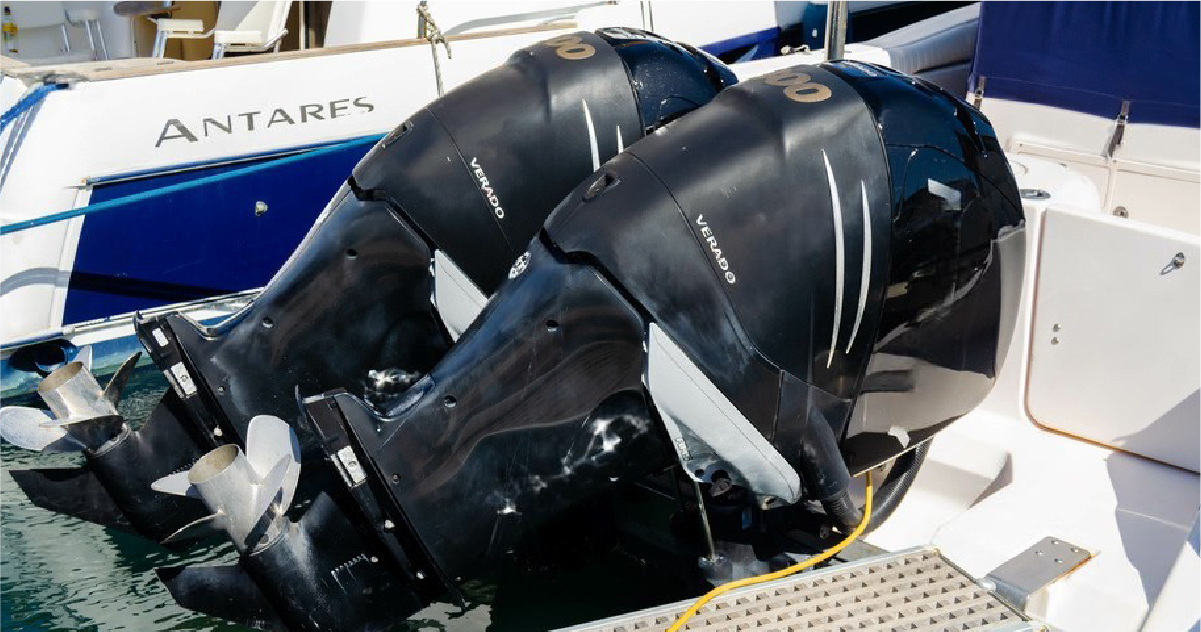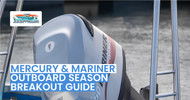Mercury & Mariner Outboard Season Breakout Guide 2025
The first warm days of spring always stir excitement for boat owners. The water seems to call, and your Mercury or Mariner outboard waits for you to take it out again. But before that key turns and the throttle moves, there’s one step that matters most, a proper season breakout.
It’s not only about getting your engine to start. It’s about keeping it strong, steady, and tension-free through every ride. A prepared motor won’t stall halfway, rust out, or give you fuel troubles after months of rest.
In this guide, we’ll learn every step from identifying your outboard model to preseason checks, in-season care, and post-season storage, all explained in simple, practical terms. Mercury or Mariner, you’ll know exactly how to keep it in top condition year after year.
Mercury & Mariner Basics: Identification & Model Info

Adobe Stock/Zoran Karapancev
Mariner models, in particular, can be tricky since decals don’t always match model years. The Mariner model year guide is a lifesaver. Use these charts to confirm your engine’s exact year, not just the year you bought it. Matching model info ensures you follow the correct service intervals and specifications, especially for older or international versions.
Why Correct Model Identification Matters
A mismatched part can cause more harm than good. Using the wrong impeller size, fuel filter, or oil type might not show issues immediately, but it can shorten engine life. Correct identification ensures:
- The right Mercury & Mariner engine parts fit and function properly
- You avoid over- or underservicing
- You protect your warranty (if applicable)
- And your outboard performs the way it was engineered to
So, take a few minutes to verify your model before starting the season breakout. It’s one of the simplest steps that can save hours of frustration later.
Preseason / Spring Breakout
Your engine’s preseason breakout is its first wake-up call after a long pause. Skip it, and you might run into repairs that drain your wallet fast. Let’s see how to bring your Mercury or Mariner back to life for calm, steady trips on the water.
Timing: When to Start
Give yourself a head start before boating season rolls in. Begin the breakout a few weeks early; late March to early April hits the sweet spot for most areas. Living somewhere cold? Hold off until those freezing nights are gone. Cold weather returning too soon can mess things up.
External Inspection
Before anything else, give your motor a full visual inspection.
- Mounts & brackets: Check for cracks, loose bolts, or rust.
- Cowling & cover: Look for worn seals, missing screws, or rodent damage.
- Corrosion: The white or green crust on the boat shows that there must be salt or moisture buildup. For that, you should clean it with a corrosion remover and apply a protectant.
A few minutes here helps you spot problems before they become repairs.
Fuel System Prep
Fuel is one of the biggest troublemakers after winter. Stale gasoline can gum up carburetors or clog injectors that need to prepare the outboard fuel system.
- Replace old fuel filters and water separators.
- Check fuel lines for cracks or soft spots.
- Use fresh fuel and add a fuel stabilizer for ongoing protection.
- Inspect tank vents and caps; they must breathe properly.
The old gas may come to haunt when a motor is in an idle state after months without fuel treatment. For that, empty the tank and refill it with clean and stabilized fuel to ensure that things run smoothly.
Oil & Lubrication
If we talk about Mercury, it recommends changing oil before the season starts. You can even change it before storage. Oil can absorb moisture over time.
- Drain and replace engine oil and filter.
- Change gearcase lubricant (check for milky oil, which means water intrusion).
- Grease all fittings, steering linkages, and pivot points.
Fresh lubrication is for a smooth operation, and it reduces corrosion during those long summer runs.
Cooling / Water Pump / Impeller
A weak water pump is one of the most common failure points. Before launching:
- Replace your outboard water pump if it’s more than two seasons old or showing weak water flow.
- Check cooling passages for blockages.
- Run clean, fresh water through the system to flush debris.
During your first start-up, make sure the tell-tale (pee stream) is strong and steady. Weak flow may mean a blockage or a failing impeller.
Electrical & Ignition Systems
- Cold storage can corrode terminals or drain batteries.
- Fully charge and test your battery.
- Clean connections and terminals; apply dielectric grease.
- Inspect spark plugs for fouling; replace if worn or oily.
- Check wiring for cracks or corrosion.
A healthy electrical system is essential for a reliable start every time.
Propeller & Lower Unit
Your propeller and lower unit do more than push the boat; they affect performance, vibration, and fuel economy.
- Inspect for nicks, bends, or hub damage.
- Grease the shaft and torque the prop nut to the specified torque.
- Check lower-unit seals for leaks.
A smooth prop means a smoother ride and less strain on your engine.
If you are planning to upgrade or replace, it’s worth checking out some of the best rated outboard motors trusted by boat owners for long-term performance and reliability.
Corrosion Control & Anode Check
Sacrificial anodes (zincs) are your first defense against corrosion.
- Replace any that are more than 50% worn.
- Inspect mounting screws and ensure good contact with metal surfaces.
- Never paint anodes; they must stay bare to do their job effectively.
Initial Test Run / Break-In
After all checks are done, it’s time for a cautious first run.
- Connect water via flushing muffs or a tank.
- Start and let the engine idle for several minutes.
- Gradually increase the throttle, listening for odd noises.
- Watch temperature, oil pressure, and cooling stream.
If the engine is new or rebuilt, follow Mercury’s official break-in schedule. It’s the key to long-term reliability.
In-Season Maintenance

Adobe Stock/chocolatefather
Once you’re back on the water, regular attention keeps your Mercury or Mariner running flawlessly all summer.
- Routine Pre-Trip Checks: Make sure that the oil level, fuel filter, and battery charge are checked before each trip. Check and see whether there are any leaks or loose wires. It is less than five minutes, but it may save your whole day in the water.
- Monitor Anodes & Corrosion: Anodes need to be checked by saltwater users once every month. Always have a corrosion inhibitor and spray all free aluminum and steel after each trip.
- Prop Inspections: If you’ve hit sand or debris, stop and check your aluminum or stainless propeller immediately. A slightly bent blade can throw your engine off balance and damage seals.
- Fuel & Water Handling: Always buy fuel from high-turnover stations. Avoid ethanol-heavy fuel if possible, and use a stabilizer regularly. Drain any water that collects in the separator filter bowl.
- Clean & Maintain Gauges, Screens, and Connectors: Salt, humidity, and UV take their toll. Wipe down connectors, inspect gauge wiring, and clean digital screens gently to prevent corrosion buildup.
- Flush After Saltwater Use: Every saltwater trip should end with a freshwater flush. It prevents salt crystallization inside the cooling passages, a major cause of overheating.
- Keep Cover & Exterior Clean: Salt spray corrodes quickly. Wipe the entire motor down with fresh water and spray a corrosion guard on the motor after drying. Do not use strong detergents that remove protection.
Mid-Season Servicing
Halfway through the season, perform a mini-service:
Check spark plugs, check prop shaft grease, check steering movement, check oil color or contamination, and a brief mid-season tune-up has you ahead of the game. In the event that you operate your outboard hard, long, at high RPMs, or in saline water, reduce your service schedules. Apply high-quality synthetic oil and anti-corrosion additives.
Troubleshooting Common Issues
During the season, you might encounter
- Overheating: check water intake and impeller.
- Poor acceleration: inspect the prop, fuel filter, and spark plugs.
- Fuel starvation: vent issues or clogged filters.
- Smoky exhaust: excess oil or carburetor imbalance.
Address these quickly to avoid major breakdowns.
In-Season Checklist
Keep this quick list handy:
- Check oil before every outing
- Inspect prop and anodes monthly
- Flush the cooling system after saltwater trips
- Replace filters mid-season if needed
- Keep the engine clean and dry
Post-Season / Shutdown & Storage
When you are done with the trip at the end of the season, do not simply drag the boat out and walk off. Mishandling of goods in the spring will cause 90% of the problems that people experience.
- Timing: Begin winterizing when the temperatures are regularly lower than 50 o C (100°F). One should not wait until frost strikes; it can damage things internally when it gets wet and freezes.
- Fuel System Winter Prep: Add a final tank fuel stabilizer. Run the engine to circulate it for 10 minutes. Fuel injectors or drain carburetors. Seal air inlets and exhaust outlets to ensure that rodents or insects will not nest.
- Oil & Lubrication: Perform a final oil and gear lube change. Dirty oil left in an idle engine causes internal corrosion. Grease every fitting, especially steering and tilt mechanisms.
- Cooling System / Antifreeze: In a freezing location, put marine antifreeze through the system. Blow out or drain off water. Automobile antifreeze should not be used; it is harmful to marine life.
- Electrical & Ignition: Disassembly and de-battery. Keep it in a cool and dry place and charge it monthly. Apply dielectric grease to the connector and terminals.
- Corrosion & Anodes: Spray oil inside into engine cylinders and apply corrosion protectant on bare metal. Change anodes when they are approaching retirement.
- Storage Position & Environment: Keep your outboard in an upright posture to prevent the accumulation of oil and water. Loosely cover it with a breathable engine cover and make sure the area is dry and well ventilated.
- Rodent & Pest Prevention: Use steel wool or screens to stuff the opening; Mice like to nest in warm engine compartments. Do not apply food-based deterring agents that increase the number of pests.
Pre-Season Prep Forethought
Before closing the cover, leave a note or checklist for yourself on the oil type used, filters replaced, or repairs needed. Come spring, you’ll thank yourself.
Post-Season Checklist
- Drain fuel or stabilize
- Change oil and gear lube
- Grease fittings
- Protect electrical parts
- Fog the engine
- Cover and store upright
Note: Always consult your specific engine manual for exact maintenance intervals.
Conclusion
Your Mercury or Mariner outboard is not just a motor, but it is the heart of your boating experience. The more it is treated properly in all seasons, the more it will continue starting off strong, idling, and taking you through the countless trips without any concern.
It is not about a seasonal breakout that is complex, but rather about consistency. The reliability is created by every little step from the first pre-spring check to the last fall flush.
Need help finding the perfect marine parts, filters, or anodes for your Mercury or Mariner? Call us at 270-618-5200.
Posted by Brian Whiteside


